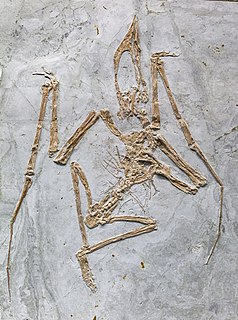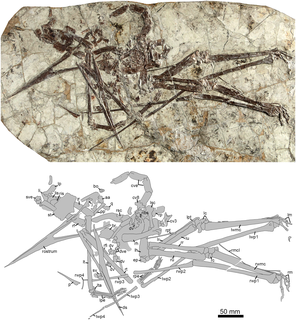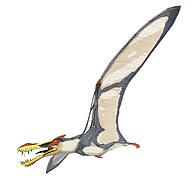
Caulkicephalus is a genus of anhanguerid pterosaur from the Isle of Wight off the coast of England. It lived during the Early Cretaceous period, about 130 million years ago.

Tapejaridae are a family of pterodactyloid pterosaurs from the Cretaceous period. Members are currently known from Brazil, England, Hungary, Morocco, Spain, the United States, and China. The most primitive genera were found in China, indicating that the family has an Asian origin.
Eopteranodon is a genus of tapejarid pterosaur from the Aptian-age Lower Cretaceous Yixian Formation of Beipiao City, Liaoning, China. The genus was named in 2005 by paleontologists Lü Junchang and Zhang Xingliao. The type and only species is Eopteranodon lii.

Chaoyangopterus is a genus of chaoyangopterid pterosaur known from a partial skeleton found in Liaoning, China. Chaoyangopterus was found in rocks dating back to the Aptian-age Lower Cretaceous Jiufotang Formation of Dapingfang, Chaoyang.

Istiodactylus is a genus of pterosaur that lived during the Early Cretaceous period, about 120 million years ago. The first fossil was discovered on the English Isle of Wight in 1887, and in 1901 became the holotype specimen of a new species, O. latidens, in the genus Ornithodesmus. This species was moved to its own genus, Istiodactylus, in 2001; this name is Greek for "sail finger". More specimens were described in 1913, and Istiodactylus was the only pterosaur known from three-dimensionally preserved fossils for much of the 20th century. In 2006, a species from China, I. sinensis, was assigned to Istiodactylus, but it has also been suggested to belong to a different genus.

Feilongus is an extinct genus of ctenochasmatid pterodactyloid pterosaur from the Barremian–Aptian-age Lower Cretaceous Yixian Formation of Beipiao, Liaoning, China.

Haopterus is a genus of pterodactyloid pterosaur from the Barremian-Aptian-age Lower Cretaceous Yixian Formation of Liaoning, China. Its fossil remains dated back 124.6 million years ago.
Liaoxipterus is a genus of pterodactyloid pterosaur from the Barremian-Aptian-age Lower Cretaceous Jiufotang Formation of Chaoyang, Liaoning, China. The type species is Liaoxipterus brachyognathus. The genus name is derived from the discovery locality Liaoxi and a Latinised Greek pteron, "wing". The specific name is derived from Greek brachys, "short" and gnathos, "jaw".

Sinopterus was a genus of tapejarid pterodactyloid pterosaur from the Aptian-age Lower Cretaceous Jiufotang Formation of Chaoyang, Liaoning, China. It was first described and named by Wang Xiaolin and Zhou Zhonghe. Three species have been classified in this genus, though only two are generally considered to be valid. Sinopterus is known for its proportionally large skull, which has a birdlike pointed beak, a long bony crest that starts with a tall premaxilla and goes back along the middle of the skull to form a point overhanging the rear of the skull, and its lack of teeth.

Jidapterus is a genus of chaoyangopterid pterosaur from the Aptian-age Lower Cretaceous Jiufotang Formation of Chaoyang, Liaoning, China. The genus was in 2003 named by Dong Zhiming, Sun Yue-Wu and Wu Shao-Yuan. The type species is Jidapterus edentus. The genus name is derived from Jílín Dàxué or "Jilin University" and a Latinized Greek pteron, "wing". The specific name means "toothless" in Latin.

Nurhachius is a genus of istiodactylid pterodactyloid pterosaur from the Barremian to Aptian-age Lower Cretaceous Jiufotang Formation of Chaoyang, Liaoning, China. Its fossil remains dated back about 120 million years ago.
Longchengpterus, sometimes misspelled as "Lonchengopterus", is a genus of istiodactylid pterodactyloid pterosaur from the Barremian-Aptian-age Lower Cretaceous Jiufotang Formation of Chaoyang, Liaoning, China. Its fossil remains dated back about 120 million years ago.

Liaoningopterus, sometimes misspelled as "Liaoningopteryx", was a genus of anhanguerid pterodactyloid pterosaur from the Barremian-Aptian-age Lower Cretaceous Jiufotang Formation of Chaoyang, Liaoning, China.

Ornithocheiridae is a group of pterosaurs within the suborder Pterodactyloidea. These pterosaurs were among the last to possess teeth. Members that belong to this group lived from the Early to Late Cretaceous periods, around 140 to 90 million years ago.

Istiodactylidae is a small family of pterosaurs. This family was named in 2001 after the type genus Istiodactylus was discovered not to be a member of the genus Ornithodesmus.

Guidraco is an extinct genus of toothed pterodactyloid pterosaur known from the Early Cretaceous of Liaoning Province, northeast China. According to many recent studies, Guidraco is a member of the group Anhanguerinae, a subfamily belonging to the larger group Anhangueridae.

Ornithocheirae is an extinct clade of pteranodontoid pterosaurs from the Early Cretaceous to the Late Cretaceous of Asia, Europe, North America and South America. It was named by Harry Seeley in 1870 as a family that contains Ornithocheirus and its relatives. The name was emended to Ornithocheiridae, to match the requirements of the ICZN Code that a family-ranked clade should end with an -idae suffix. Brian Andres (2010) in his review of pterosaur phylogeny, defined the name Ornithocheirae phylogenetically, as a node-based taxon consisting of the last common ancestor of Anhanguera and Ornithocheirus and all its descendants. Thus Ornithocheirae is defined to include two families, the Anhangueridae and the Ornithocheiridae, following the opinion of Alexander Kellner and Andres that these families should not be synonymized based on their original phylogenetical definitions. However, subsequent studies in 2019 have found Ornithocheirae to be a more inclusive group containing both Anhangueria and Targaryendraconia.

Chuanqilong is a monospecific genus of basal ankylosaurid dinosaur from the Liaoning Province, China that lived during the Early Cretaceous in what is now the Jiufotang Formation. The type and only species, Chuanqilong chaoyangensis, is known from a nearly complete skeleton with a skull of a juvenile individual. It was described in 2014 by Fenglu Han, Wenjie Zheng, Dongyu Hu, Xing Xu, and Paul M. Barrett. Chuanqilong shows many similarities with Liaoningosaurus and may represent a later ontogenetic stage of the taxon.

Ornithocheiromorpha is a group of pterosaurs within the suborder Pterodactyloidea. Fossil remains of this group date back from the Early to Late Cretaceous periods, around 140 to 92.5 million years ago. Ornithocheiromorphs were discovered worldwide except Antarctica, though most genera were recovered in Europe, Asia and South America. They were the most diverse and successful pterosaurs during the Early Cretaceous, but throughout the Late Cretaceous they were replaced by better adapted and more advanced pterosaur species such the pteranodontids and azhdarchoids. The Ornithocheiromorpha was defined in 2014 by Andres and colleagues, and they made Ornithocheiromorpha the most inclusive clade containing Ornithocheirus, but not Pteranodon.



























